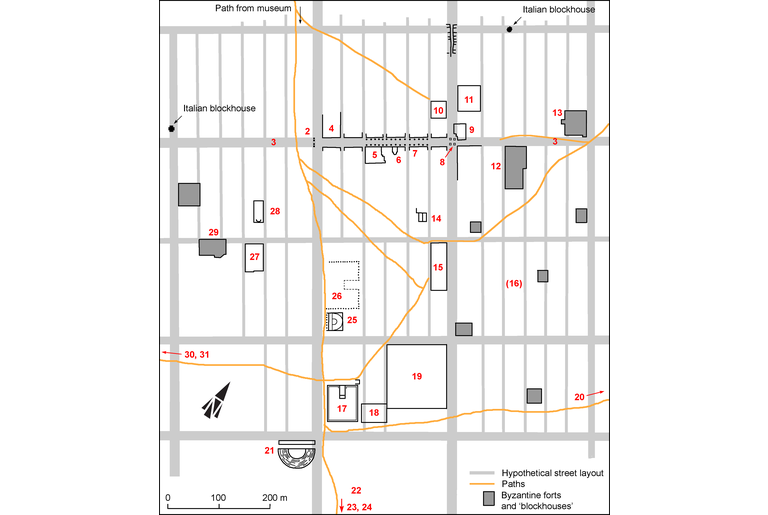Public honors for Arsinoe II
IGCyr033700
Trismegistos ID: 6016
Source Description
Support
Limestone block, probably belonging to the same monument as IGCyr033800; recut at right and reused upside down in Roman times (0.73; 0.35; -).
Layout
Inscribed on the face in three lines centered along vertical axis.
Letters
0.06; carefully cut, similar to IGCyr033800.
Place of Origin
Date
Between 251 and 168 B.C. (context, lettering, reign)
Findspot
Seen by all visitors since J.-R. Pacho (1825) at Ptolemais pleiades; HGL : recut and reused in the rostra of the Square of the Cisterns , 5th file, 2nd block from left.
Last recorded Location
Seen by C. Dobias-Lalou in 1979 at place of re-use.
Text constituted from
Transcription from stone (CDL).
Bibliography
Letronne in Pacho, 1827 Pacho, J.-R., 1827, Relation d'un voyage dans la Marmarique, la Cyrénaïque et les oasis d'Audjelah et de Maradeh, pendant les années 1824 et 1825, Paris - see in bibliography , pl. LXXIV and pp. 397-399 (= Letronne, 1828 Letronne, A.-J., 1828, Sur quelques inscriptions inédites trouvées dans la Cyrénaïque, Journal des Savants (JS), 259-265 - see in bibliography , pp. 259-261), whence CIG Corpus Inscriptionum Graecarum, I-IV, Berlin, 1828-1877 - see in bibliography 5184 and OGIS Dittenberger, W. (ed.), Orientis Graeci Inscriptiones Selectae, I-II, Leipzig, 1903-1905 - see in bibliography 33; Oliverio, 1932-1933 Oliverio, G., 1932-1933, Documenti antichi dell'Africa Italiana, I, fasc. 1-2, Bergamo - see in bibliography , pp. 68-69, n. 3, fig. 7, whence SEG Supplementum Epigraphicum Graecum, Leiden, then Amsterdam, 1923-1971, then 1979- - see in bibliography , 9.357.
Cf. Moretti, 1976 Moretti, L., 1976, Epigraphica: 15 Per la storia di Tolemaide in Cirenaica, Rivista di Filologia e Istruzione Classica (RFIC)104, 186-191 - see in bibliography (= Moretti, 1990 Moretti, L., 1990, Tra epigrafia e storia. Scritti scelti e annotati, Vetera, 5, Roma - see in bibliography , pp. 343-348), whence SEG Supplementum Epigraphicum Graecum, Leiden, then Amsterdam, 1923-1971, then 1979- - see in bibliography , 26.1838; Robert, Bulletin Épigraphique Robert, J. and L., Bulletin Épigraphique in Revue des Études Grecques (REG)1938-1984 - see in bibliography , 1977.593; Laronde, 1987 Laronde, A., 1987, Cyrène et la Libye hellénistique. Libykai historiai de l’époque républicaine au principat d’Auguste, Paris - see in bibliography , pp. 398, 402, whence SEG Supplementum Epigraphicum Graecum, Leiden, then Amsterdam, 1923-1971, then 1979- - see in bibliography , 38.1905; Marquaille, 2003 Marquaille, C., 2003, The Ptolemaic ruler as a religious figure in Cyrenaica, Libyan Studies (LibStud), 34, 25-42 - see in bibliography , and Dobias-Lalou, Bulletin Épigraphique Dobias-Lalou, C.Bulletin Épigraphique in Études Grecques (REG)1987- - see in bibliography , 2005.620, whence SEG Supplementum Epigraphicum Graecum, Leiden, then Amsterdam, 1923-1971, then 1979- - see in bibliography , 53.2028; Mueller, 2004 Mueller, K., 2004, Dating the Ptolemaic city-foundations in Cyrenaica: a brief note, Libyan Studies (LibStud)35, 1-10 - see in bibliography , and Dobias-Lalou, Bulletin Épigraphique Dobias-Lalou, C.Bulletin Épigraphique in Études Grecques (REG)1987- - see in bibliography , 2007.568, whence SEG Supplementum Epigraphicum Graecum, Leiden, then Amsterdam, 1923-1971, then 1979- - see in bibliography , 54.1779bis; Criscuolo, 2001 Criscuolo, L., 2001, Filometore a Ptolemais di Cirenaica: a proposito di SEG XLVI 2214, Zeitschrift für Papyrologie und Epigraphik (ZPE)135, 264-266 - see in bibliography , whence SEG Supplementum Epigraphicum Graecum, Leiden, then Amsterdam, 1923-1971, then 1979- - see in bibliography , 51.2213.
Text
Apparatus
French translation
(La statue de la) reine Arsinoè, Déesse [Philadelphe], fille de Ptolémée et de Bérénice, [Dieux Sôtères] (a été érigée par) la cité.
English translation
(The statue of) queen Arsinoe, Goddess [Philadelphos], daughter of Ptolemy and of Berenice, [Gods Soteres] (has been dedicated by) the city.
Italian translation
(La statua della) regina Arsinoe, Dea [Filadelfo], figlia di Tolemeo e di Berenice, [Dèi Soteri] (è stata eretta dalla) città.
Arabic translation
Arabic translation
تمثال الملكة آرسينوي، المؤلهة [فيلادلفوس]، ابنة بطليموس وبيرنيكي، [المؤلهين سوتيرس]، (كان قد نُصبَ) من قبل المدينه.
Commentary
At Ptolemais there are three similar bases for members of the Lagid family (IGCyr033700, IGCyr033800 and IGCyr084300), which were re-used in the same Roman monument that seems to lay upon the foundations of a Hellenistic monumental base to which they probably all belonged, perhaps along with a fourth one, now lost. The Roman monument is part of the so-called Square of the Cisterns, which may have been formerly either the gymnasium ( Stucchi, 1975 Stucchi, S., 1975, Architettura cirenaica, Monografie di Archeologia libica9, Roma - see in bibliography , p. 128, footnote 3) or the agora ( Laronde, 1987 Laronde, A., 1987, Cyrène et la Libye hellénistique. Libykai historiai de l’époque républicaine au principat d’Auguste, Paris - see in bibliography , p. 398).
The present dedication may have been erected earlier than the two others, which, as Criscuolo, 2001 Criscuolo, L., 2001, Filometore a Ptolemais di Cirenaica: a proposito di SEG XLVI 2214, Zeitschrift für Papyrologie und Epigraphik (ZPE)135, 264-266 - see in bibliography established, were modelled on it between 168 and 164 B.C. in order to form a monumental base. However, the lettering does not show a span of time as long as one century (Arsinoe died in 270).
It is not clear whether the city mentioned at l. 3 might have been still Barka and not yet Ptolemais, for the cult of Arsinoe was specially developed in harbours and not necessarily in the city-centre; however, as we now know that Ptolemais was founded probably after 260 ( Laronde, 1987 Laronde, A., 1987, Cyrène et la Libye hellénistique. Libykai historiai de l’époque républicaine au principat d’Auguste, Paris - see in bibliography , p. 398) and certainly before 251 ( Mueller, 2004 Mueller, K., 2004, Dating the Ptolemaic city-foundations in Cyrenaica: a brief note, Libyan Studies (LibStud)35, 1-10 - see in bibliography ), it is highly plausible that the dedication to Arsinoe was erected by the city of Ptolemais in a prominent place.
Creative Commons Attributions-NonCommercial 4.0 International License.
All citation, reuse or distribution of this work must contain a link back to DOI: http://doi.org/10.6092/UNIBO/IGCYRGVCYR and the filename (IGCyr000000 or GVCyr000), as well as the year of consultation.
